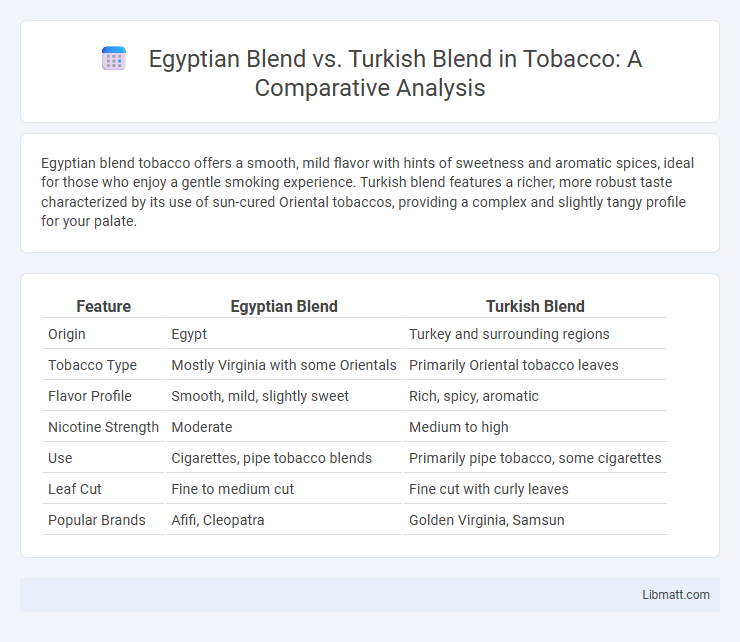Egyptian blend tobacco offers a smooth, mild flavor with hints of sweetness and aromatic spices, ideal for those who enjoy a gentle smoking experience. Turkish blend features a richer, more robust taste characterized by its use of sun-cured Oriental tobaccos, providing a complex and slightly tangy profile for your palate.
Table of Comparison
| Feature | Egyptian Blend | Turkish Blend |
|---|---|---|
| Origin | Egypt | Turkey and surrounding regions |
| Tobacco Type | Mostly Virginia with some Orientals | Primarily Oriental tobacco leaves |
| Flavor Profile | Smooth, mild, slightly sweet | Rich, spicy, aromatic |
| Nicotine Strength | Moderate | Medium to high |
| Use | Cigarettes, pipe tobacco blends | Primarily pipe tobacco, some cigarettes |
| Leaf Cut | Fine to medium cut | Fine cut with curly leaves |
| Popular Brands | Afifi, Cleopatra | Golden Virginia, Samsun |
Introduction to Egyptian and Turkish Blends
Egyptian blend and Turkish blend are two distinctive types of tobacco used primarily in pipe smoking and premium cigarettes. Egyptian blend is renowned for its smooth, mild flavor derived from sun-cured Virginia tobacco with a hint of aromatic leaf, while Turkish blend features a robust, spicy profile created from sun-cured Oriental tobaccos like Basma, Smyrna, and Yenidje. Both blends emphasize the unique qualities of their native tobacco regions, influencing taste preferences and cultural significance in the global tobacco market.
Historical Background of Both Blends
Egyptian blend tobacco traces its origins to the early 19th century, evolving from the cultivation of aromatic tobacco varieties along the Nile River and prominent use in traditional Egyptian water pipes (hookahs). Turkish blend tobacco, emerging during the Ottoman Empire, is characterized by its incorporation of sun-cured, small-leafed Oriental tobaccos from regions like Thrace and Macedonia, prized for their rich, spicy, and slightly acidic flavor profiles. Both blends gained widespread popularity through the 19th and early 20th centuries, influencing global pipe tobacco markets and shaping smoking cultures in Europe and the Middle East.
Key Ingredients in Egyptian Blend
Egyptian blend typically contains a rich mixture of Oriental tobacco varieties like Latakia and Turkish tobacco, combined with heavier Virginia leaves, creating a bold and smoky flavor profile. Turkish tobacco contributes a spicy, aromatic character, while Latakia adds a deep, smoky essence that is distinctively different from the lighter and sweeter profile of a typical Turkish blend. The interplay of these key ingredients results in a complex, full-bodied smoking experience favored in traditional Egyptian tobacco products.
Essential Components of Turkish Blend
Turkish blend tobacco primarily consists of sun-cured leaves from small-leafed Oriental tobacco varieties grown in Turkey, Greece, and the Balkans. These leaves provide a distinct aromatic profile characterized by mild acidity, a spicy and smoky flavor, and a natural sweetness due to the fermentation and drying process. The essential components include bright, oily, and fragrant tobacco strands, often complemented by a touch of Virginia or Burley tobaccos in some blends to enhance sweetness and body.
Flavor Profiles: Egyptian vs Turkish
Egyptian blend tobacco features a smooth, rich flavor with notes of honey and spice, offering a mild to medium strength that appeals to smokers seeking a balanced experience. Turkish blend, on the other hand, is characterized by a robust, earthy taste with hints of sweet and smoky undertones, providing a fuller-bodied and more intense smoking sensation. The distinct curing methods and indigenous leaf varieties in both Egyptian and Turkish blends contribute to their unique aromatic and flavor profiles.
Preparation Methods Compared
Egyptian blend tobacco is typically prepared using air-curing methods that emphasize slow drying to preserve its natural flavors and enhance its smoothness. Turkish blend tobacco undergoes sun-curing, which intensifies its aromatic qualities and provides a spicier, more robust flavor profile. Your choice between these blends depends on whether you prefer the mellow sweetness of air-cured Egyptian tobacco or the bold, aromatic intensity of sun-cured Turkish tobacco.
Cultural Significance of Each Blend
Egyptian blend tobacco is deeply rooted in Middle Eastern culture, often associated with traditional shisha smoking rituals that emphasize social bonding and hospitality. Turkish blend tobacco reflects a rich heritage tied to Ottoman history, embodying a centuries-old practice of tobacco cultivation and intricate smoking ceremonies. Both blends carry cultural significance that highlights regional customs, making them symbols of identity and communal experience in their respective societies.
Health Benefits and Concerns
Egyptian blend tobacco, often characterized by its smooth, mild flavor, typically contains lower nicotine levels, potentially reducing addiction risk but still posing health hazards like respiratory issues and cancer. Turkish blend tobacco is known for its higher nicotine content and robust taste, which may increase the likelihood of dependence and associated health concerns such as cardiovascular disease and lung damage. Both blends expose users to harmful chemicals and carcinogens, emphasizing the need for cautious consumption to mitigate health risks.
Popular Uses in Culinary Traditions
Egyptian blends, known for their rich, dark, and slightly sweet tobacco, are commonly used in shisha and hookah smoking, which complements the Middle Eastern culinary tradition of social gatherings centered around flavorful grilled meats and spiced sweets. Turkish blends, with their robust, bold, and often spiced tobacco characteristics, are favored in traditional Turkish coffeehouses where the intense smoky flavor enhances the experience of sipping strong, aromatic coffee paired with baklava or pistachio desserts. Your choice between these blends can elevate cultural authenticity and enjoyment during culinary and social occasions.
Choosing the Right Blend for Your Needs
Egyptian blend tobacco offers a smooth, rich flavor with a hint of sweetness, ideal for those seeking a mellow smoking experience, while Turkish blend is characterized by its aromatic, spicy notes and fuller body, catering to smokers who prefer a more robust taste. Your choice should align with personal flavor preferences and the smoking occasion, as Egyptian blends tend to burn slower and cooler, making them suitable for relaxed sessions. Selecting the right blend involves considering these distinct profiles to enhance your enjoyment and meet your specific smoking needs.
Egyptian blend vs Turkish blend Infographic

 libmatt.com
libmatt.com